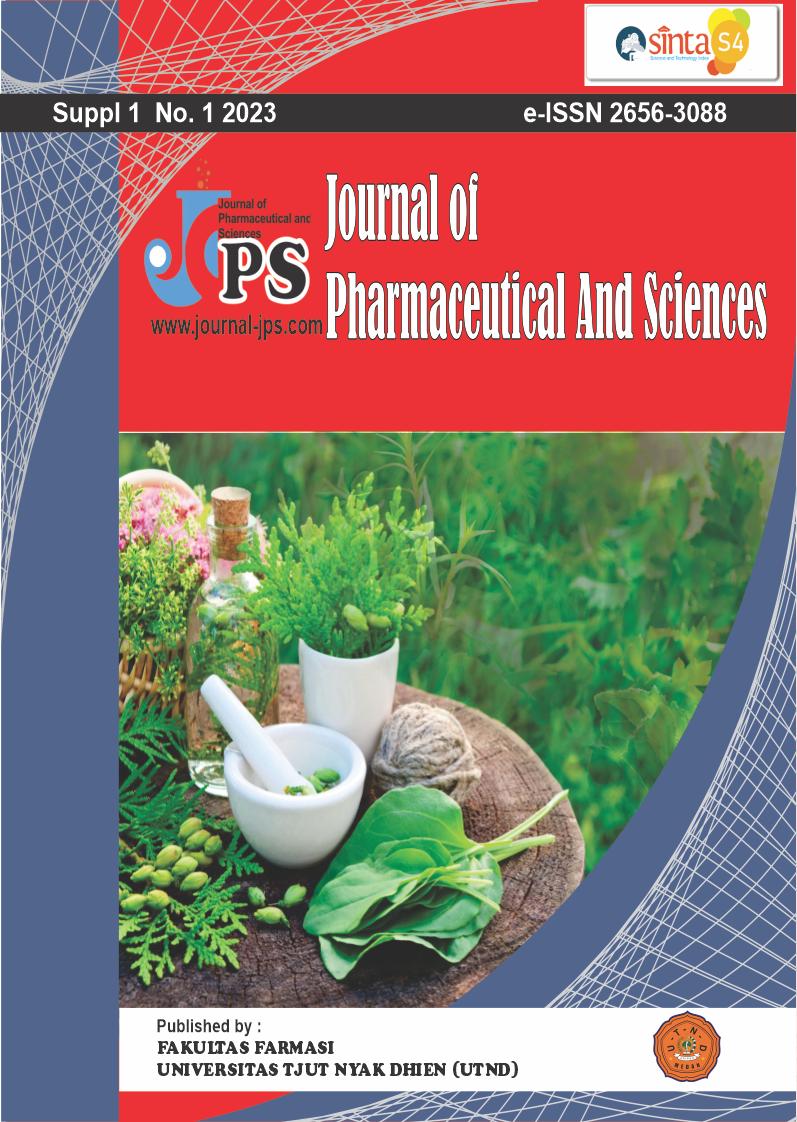Antibacterial Activity Test of Ethanol Fraction of Moringa Leaves (Moringa oleifera L.) Against Staphylococcus aureus and Staphylococcus epidermidis
Main Article Content
Page: 152-158
Abstract
Moringa olifera L. is a herbaceous plant that consists of phytochemicals such as flavonoids, saponins cytokinins, acid-caffeoylquinic and contains unsaturated fatty acids such as linoleic (omega 6) and alfalinolenat (omega 3). This research aimed to determine the chemical compound content in the ethanol fraction of Moringa leaves and test its antibacterial activity against Staphylococcus aureus and Staphylococcus epidermidis. Phytochemical screening was carried out through a color reaction using a certain reagent; then the antibacterial activity test was carried out using the disc diffusion method with ethanol fraction concentrations of 15%, 30%, 45%, and 60%. The results showed that the compounds contained in the ethanol fraction of Moringa leaves were alkaloid, flavonoid, saponin, and tannin. The diameter of the inhibition zone for S. aureus bacteria is 7.43 mm – 10.16 mm, while for S. epidermidis bacteria is in the range 7.43 mm – 10.48 mm. It can be concluded that the ethanol fraction of Moringa leaves has antibacterial activity against S. aureus and S. epidermidis bacteria.
Downloads
Article Details

This work is licensed under a Creative Commons Attribution-NonCommercial-ShareAlike 4.0 International License.
References
Acumedia. (2011). Muller Hinton Agar. PI 7101. Rev 03.
Agustie, A.W.D., dan Ratno A.S.A. (2013). Uji Aktivitas Antibakteri Ekstrak Maserasi Daun Kelor (Moringa oleifera L.) terhadap Bakteri Staphylococcus aureus. Jurnal Biomedika. 6(2):18-23.
Chukwuebuka, E. (2015). Moringa oleifera “The Mother”s Frien Internasional. Journal of Nutrition and Food Sciences. 4(6): 624-630.
Dima, L.L.R.H., Fatimawali, W.A. dan Lolo. (2016). Uji Aktivitas Antibakteri Ekstrak Daun Kelor (Moringa oleifera L.) Terhadap Bakteri Escherichia coli dan Staphylococcus aureus. Jurnal ilmiah farmasi. 5(2):2302-2493
Fuglie, L.J. (2001). The Miracle Tree (The Multiple Attributes of Moringa). Senegal: CWS Dakkar.
Gaby. (2009). Formulasi Gel Pacar Air (Impatiens balsamina Linn.) terhadap Propionibacterium acnes dan Staphylococcus epidermidis. Pharm Sci Res ISSN. 1(1):30-43.
Ibrahim, N. and Kebede, A. (2020). In vitro antibacterial activities of methanol and aqueous leave extracts of selected medicinal plants against human pathogenic bacteria. Saudi J. Biol. Sci. 27 (9): 2261–2268
Jawetz, M., and Aldebarg’s. (2010). Mikrobiologi Kedokteran Edisi 23. Jakarta: Salemba Medika.
Kasolo, J.M., Bimenya, G.S., Ojok, L. and Wogwal, O. (2011). Phythochemicals and Acute Toxicity of Moringa Oleifera Roots in Mice. Journal of Pharmacognosy and Phytotherapy. 3:38-42
Leggett, M.J, McDonnell, G., Denyer, S.P. (2012). Bacterial spore structures and their protective role in biocide resistance. J. Appl. Microbiol. 113(3): 485–498,
Marcus, A.C. and Nwineewii, J.D. (2015). Studies on the Crude Extract of Moringa oleifera Leaves for Preliminary Identification of some Phytochemicals and Organic Functions. Journal of Applied Chem. 8(2):1-5.
Nurcahyati, E. (2014). Khasiat Dahsyat Daun Kelor. Jendela Sehat: Jakarta
Pratiwi, L.F., Achmad, M, Ronny dan Suwidjiyo, P. (2016). Ekstrak Etanol, Ekstrak Etil Asetat, Fraksi Etil Asetat, dan Fraksi N-heksan Kulit Manggis (Garcinia mangostana L.) Sebagai Sumber Zat Bioaktif Penangkal Radikal Bebas. Journal of Pharmaceutical Science and Clinical Research. 1(1): 71-82.
Pratiwi, S.T. (2008). Mikrobiologi Farmasi. Jakarta: Pustaka Bunda.
Pratiwi, R.S., Tjiptasurasa, dan Retno, W. (2011). Aktivitas Antibakteri Ekstrak Etanol Kayu Nangka (Artocarpus heterophylla Lmk.) terhadapBacillus subtills danEscherichia coli. Jurnal Pharmacy. 8(3):1-5
Randa. (2012). 58 QA Question & Answer Seputar Diet, Makanan dan Suplemen. Jakarta: Penebar Swadata Grup.
Rampadarath, S,, Puchooa, D, and Ranghoo, S.V.M. (2014). Antimicrobial, phytochemical, and larvicidal properties of Jatropha multifida Linn. Asian Pacific Journal of Tropical Medicine. 7(1):380–383.
Retnaningsih, A., Primadiamanti, A dan Febrianti. (2019). Uji Daya Hambat Ekstrak Etanol Daun Ungu (Graptphyllum pictum (L) GRIFF) Terhadap Bakteri Staphylococcus epidermidis Dan Bakteri Propionibacterium acnes Penyebab Jerawat Dengan Metode Cakram. Jurnal Analis Farmasi, 4(1):1-9.
Sabandar, C. W. (2013). Medicinal property, phytochemistry and pharmacology of several Jatropha species (Euphorbiaceae): A review’, Phytochemistry. Elsevier Ltd. 85:7–29.
Salimi, Y.K., Bialangi, N. dan Saiman. (2017). Isolasi dan Identifikasi Senyawa Metabolit Skunder Ekstrak Metanol Daun Kelor (Moringa oleifera Lamk.). Jurnal Akademik. 6(2). 5-11.
Savitri, E., Fakhrurrazi, dan Harris A. (2018). Uji Antibakteri Ekstrak Daun Kelor (Moringa oleifera L.) Terhadap Pertumbuhan Bakteri Staphylococcus aureus. Jurnal JIMVET E-ISSN, 2(3): 373-379
Syahrina, S., Asfianti, V. and Gurning, K. (2020). Phytochemical Screening and Anti-Hyperuricemia Activity Test In Vivo of Ethanolic Extract of Shallot (Allium cepa L.) Skin. Borneo J Pharm. 3(3):146-51.
Sihombing, M.C.H., Simbala, H.E.I. dan Yudistira. (2018). Isolasi, Identifikasi Secara Molekuler Menggunakan Gen 16S Rrna dan Uji Aktivitas Antibakteri dari Bakteri Simbiona Endofit Alga Padina sp. Jurnal Ilmiah Farmasi, 7(2): 42-45.
Teanpaisan, R., Kawsud, P and Pahumunto, N. (2016). Journal of Traditional and Complementary Medicine Screening for Antibacterial and Antibiotic fi lm Activity in Thai medicinal plant extracts against oral Microorganisms. Journal of Traditional Chinese Medical Sciences. Elsevier Ltd, pp.6–11
Tunas, T.H., Edy, H.J. dan Siampa, J.P. (2019). Efek Aktivitas Ekstrak Etanol Daun Kelor (Moringa olifera Lam) Dalam Sediaan Masker Peel-off Ekstrak Etanol Daun Kelor Jurnal MIPA. 8(3):112-115





